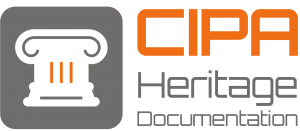Aziliz Vandesande and Mario Santana
ArchDOC | Architectural Heritage Documentation for Conservation
ArchDOC is a yearly workshop part of the course Built Heritage Documentation which is taught in the Advanced Master of Science in Conservation of Monuments and Sites at the Faculty of Engineering Science of the University of Leuven in Belgium. The workshop is a learning partnership with several EU and international experts and is endorsed by The ICOMOS/ISPRS Scientific Committee on Heritage Documentation (CIPA).
In short, ArchDOC is a one-week intensive workshop that provides both a theoretical and hands-on introduction to the highly specialised subject of built heritage documentation. Students who take part in this course, gain knowledge and experience in the utility and limits of a variety of surveying and 3D documentation techniques. The workshop focuses on documenting the reality of existing buildings and built heritage sites, which are characterised by complex geometries, different layers of interventions, and changes in constructive systems.
2021 marked the 20th edition of ArchDOC, with 20 post-initial master students from 10 countries who embarked on a one-week intensive built heritage documentation workshop. This workshop was supported and guided by expert instructors from the Faculty of Engineering Science of the University of Leuven and Carleton Immersive Media Studio and department of Civil and Environmental Engineering at Carleton University, as well as the Politecnico di Milano, the Politecnico di Torino, the National Technical University of Athens, the Université de Liège, Erfgoed Leiden en Omstreken, and the Public Works and Government Services Canada.
ILUCIDARE meets ArchDOC | Autumn School on Built Heritage Documentation
During the week of 25-29 October, the wide variety of experts and professionals from all over the world met in the Abbey of Park, a Norbertine abbey located just southeast of the city of Leuven. Buildings have a sixteenth to eighteenth-century appearance, but the layout and landscaping of the abbey date back to medieval times. Officially, Park Abbey was founded in 1129 by the Duke of Brabant, Godfrey, surnamed “the Bearded”. The Abbey of Park is one of the best-preserved monastic ensembles in Belgium; its complex building chronology shows a fascinating succession of construction, transformation, and restoration phases from the thirteenth century to the present. In 2003, the abbey grounds were let to the city of Leuven on a long lease (the Park Abbey Museum).
The first day of the Autumn School on Built Heritage Documentation served as a reconnaissance day. The event was kicked off by a guided tour to the Abbey of Park site and the vaulting system of the Saint John Evangelist church by Thomas Coomans (University of Leuven).
Next to a “tour de table” and presentation about the main expectations and outputs throughout the week, the main activity was a visit and discussion with the participants of the parallelArchDOC workshop – which took place in parallel.
The 20 post-initial master students of the ArchDOC workshop focussed on documenting the vaulting system and roof trusses of the choir and nave of the Saint John Evangelist church, as well as the spiral staircase which gives access to the organ tribune of the church.
During their intensive ArchDOC workshop, the students were tasked with:
- DRAFTING A SURVEY STRATEGY, which implies the development of a problem statement, selecting and planning their final results, as well as determining method, scale and detail selection to match their available time and resources;
- 4 days HANDS-ON HERITAGE RECORDING, which consists of data collection in teams of 5 students and 2 instructors using architectural photography for narrative, Photography for scaling/ rectification/ Structure from Motion (SfM), aerial photography (UAV), Remote Distance Measurements (RDM with Total Station) and 3D Laser scanning – and data processing according to recording sites)
- PRESENTING the results of their survey for an international audience of experts to gain feedback and create a work plan to finish the final survey results. Herewith the focus was both on the applied method of data collection and processing, as well as presenting the survey drawings.
An important takeaway was that understanding the utility of specific technologies and software can only be gained by practice, but that the same goes for understanding the context, connections, and construction history of building components.
ILUCIDARE| international connections for heritage led-innovation
To celebrate the 20th anniversary of ArchDOC, an international expert Autumn School on Built Heritage Documentation was organised in parallel. The main aim was to adapt the tested and validated ArchDOC workshop into an innovative capacity-building model that brings together international collaboration and very practice-oriented ateliers in built heritage documentation.
This Autumn School was organised by ILUCIDARE, which is a 3-year EU-funded Horizon 2020 project that builds international connections for heritage led-innovation. The project is led by the University of Leuven (Belgium) and brings together 8 international partners.
The event brought together 25 professionals from all over the world, who are experienced in built heritage documentation and had the opportunity to share their work among peers and part-take in tech demos to test the performance of different state-of-the-art tools and techniques in documentation.











